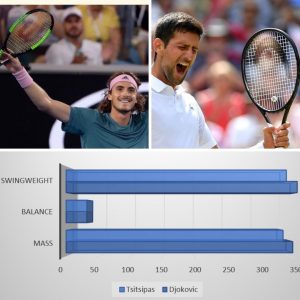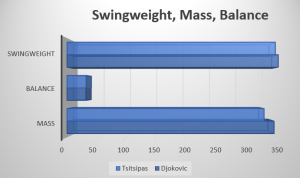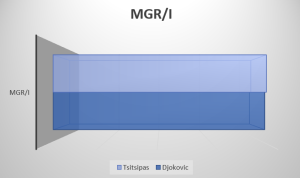Just going with my memory, this is the first time since I started doing these matchups analysis, that we have the same two players in the finals as in one of my previous analysis. I will try not to be repetitive, but the match up is worth digging in, as a lot has changed, especially on the Tsitsipas side.

The 2023 Australian Open Finals will feature Novak Djokovic and Stefanos Tsitsipas, in a match-up that promises to be both exciting and historic. Djokovic will be looking to win the 10th Australian Open title and extend his record in a race for most Grand Slams won in the Open Era. Tsitsipas, on the other hand, will aim to win his first Grand Slam final, and will be looking to get revenge for the recent Roland Garros finals loss against Djokovic. On top of that, both players can become the world number one if they win the title. A historic moment, no matter who ends up being a winner.
In terms of racket match-up, Djokovic and Tsitsipas have very different setups. Djokovic uses a racket with a higher swing weight and static weight, which allows him to play more consistently with a consistent level of required energy output from his body. This enables him to keep the ball heavy and deep in the court, which is a key aspect of his game. On the other hand, Tsitsipas has a racket with a lower static and swing weight, which means that he needs to swing with much faster racket head speed than Djokovic, resulting in more miss hits and unforced errors. His game is based around explosive footwork, early take backs and hitting the ball in front of his body on both sides, which helps him compensate for the lack of racket power. Let’s take a look at a graphical representation of the specifications:


The biggest change on Tsitsipas side is, that according to Prostock tennis, that holds his personal racket, he increased swingweight to over 350 from around 340 some years ago, by keeping the mass of the racket low. This means that in recent years he uses a more polarized racket, that I previously reported, and this enables him to play with more spin and create a heavier ball. This setup should also be more arm friendly, which is definitely what he needs as he had troubles with his elbow, which may also be part of the reason for the changes. He was playing around with 4G and Gut hybrid, but now seems to again use a full bed of 4G strings.
Tsitsipas has made some significant changes to his game since his elbow surgery in 2020. Like mentioned, he has been working on adding more weight to his racket, which has allowed him to generate more power on his shots. This has been evident in his improved serve and his ability to hit through the ball with more force. This added weight has also helped him to play more consistently, as it allows him to maintain a higher level of control over his shots.
One of the key factors that will play a role in the match is Djokovic’s ability to dictate play. With his heavy and deep shots, he will look to control the points and force Tsitsipas to play defense. Djokovic’s superior consistency and ability to hit heavy and deep shots with relative ease will put a lot of pressure on Tsitsipas to come up with creative solutions to stay in the points.
Tsitsipas, on the other hand, will look to use his speed and agility to his advantage. He will look to be aggressive and take the ball early, trying to hit through Djokovic’s heavy shots. His ability to hit flat and hard shots with his light racket setup will also be a key weapon in his arsenal, as it will allow him to dictate play and take time away from Djokovic.
Another important factor to consider is the mental aspect of the match. Djokovic has a wealth of experience in Grand Slam finals and will likely have an advantage in this regard. He has been in this position many times before and knows how to handle the pressure and emotions that come with playing in a Grand Slam final. Tsitsipas, on the other hand, is playing in his first Grand Slam final and may struggle with the added pressure and nerves.
However, Tsitsipas is a young and ambitious player who will not back down easily. He has shown that he has the ability to rise to the occasion and beat some of the best players in the world. His youth and energy will be a key factor in the match, as he will look to use his speed and agility to wear down Djokovic over the course of the match.
In addition to the changes in his racket, Tsitsipas has also made improvements in his footwork. He has been working on his explosive footwork, which allows him to get to the ball quicker and hit it earlier in the point. This has been a key factor in his ability to counter Djokovic’s heavy and deep ball, as it gives him more time to react and make adjustments to his shots.
One of the most notable improvements in Tsitsipas’ game has been his mental fortitude. He has shown a remarkable level of grit and determination in his matches, which has allowed him to come back from difficult situations and win tight matches. This mental toughness will be crucial in the final against Djokovic, as it will allow him to stay focused and maintain his level of play throughout the match.
Another area where Tsitsipas has improved is his net game. He has been working on his volleys, which has allowed him to come to the net more often and finish points at the net. This has been a key factor in his ability to disrupt Djokovic’s game, as it forces him to hit more passing shots and play more defense.
To win the Australian Open final, Tsitsipas will need to leverage his youth and energy levels to keep up with Djokovic over a possible five-set match, and maintain a high level of grit and concentration to keep his racket head speed high and explosive. He will also need to be precise with his leg work at crucial moments, in order to counter Djokovic’s heavy and deep ball coming from his racket. Djokovic, on the other hand, will need to maintain his focus and energy levels, and try not to get dragged in longer exchanges and a potential 5 set match.
He will need to do as much as possible with the first 1-2 touches of the ball, for which his racket is ideally set up. Great serves and deep returns are his especially, mostly because of his racket setup. He will try to keep the points short and dictate the play from the first shot.
It’s worth noting that there will be many other factors at play in this match beyond the racket match-up analysis. One major factor to consider is Djokovic’s recent injury. He has been dealing with a tight thigh muscle, and it remains to be seen how this will impact his performance on the court. Djokovic is known for his endurance and ability to maintain a high level of play for extended periods of time, so any limitation on his movement could have a significant impact on the match. For now the injury seemed to get better, but he wasn’t really tested, because he was able to dictate the play to dominate opponents in the last 2 rounds. It will be interesting to see how he manages it in this match and if Tsitsipas will be able to push him enough that the injury gets worse.
On top of this, these kinds of monumental situations for both players always have the potential to surprise us in many ways, where even Djokovic shows he is human, when he breaks down like he did against Medvedev in the 2020 US open finals.
Overall, the 2023 Australian Open final promises to be a match for the history books, as Djokovic looks to tie his record for most Grand Slams won with Nadal, and Tsitsipas looks to make his mark on the sport by finally breaking out, winning a GS final and becoming the world number 1 for the first time, while getting a second shot at beating Novak in a GS final. It will be an exciting match to watch, as we see the different rackets and strategies behind them at work.